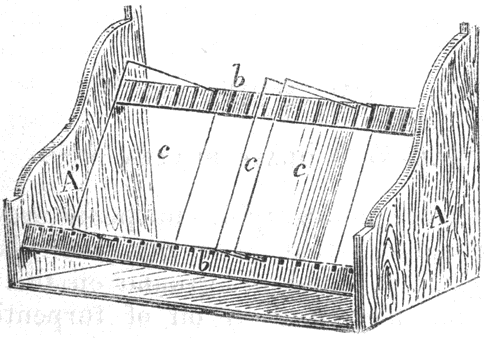
van Monckhoven, Désiré van. A Popular Treatise on Photography. Translated By W.H. Thornthwaite. London, 1863.
| [Previous] Chapter 3 | [Next] Chapter 5 | Title Page Preface Introduction |
| Table of Contents | Search this book | Albumen Home |
GLASS plates for photographic purposes are employed with ground edges-that is to say, the glasses, after being cut with a diamond, are ground on their edges by means of a fine file, aided by oil of turpentine. The object of this operation is to prevent the operator from cutting himself upon the sharp edges of the glass.
In place of crystal sheet, ordinary patent plate, or even flatted crown glasses may be used; especially for the smaller-sized (under half-plate.). Patent plate being more perfectly polished than flatted crown, is also more easily cleaned, and therefore preferable.
Whatever be the kind of glass employed, the following is the method which should be pursued in cleaning the plates whether they have been used before or not
A mixture of equal quantities of nitric acid and water is made, and the glasses covered therewith on both sides by the aid of some cotton-wool fastened to the end of a stick; and as each plate is successively treated in this manner, they are placed against the wall to drain.
Instead of nitric acid a solution of carbonate of potash, of the strength of one pound to one quart of water, may be advantageously employed. The liquid acts energetically upon plates that have been previously used, and is free from the objection to which nitric acid is open, namely, that of staining the hands yellow.
Fig. 24. Support for Cleaned Plates.
It is always a good plan to clean a number of plates at the same time-as many as twenty, for instance-because it is necessary to allow the alkaline or acid solution to act for at least an hour. The plates are then submitted to the action of a strong current. of water, and rubbed at the same time on both sides with a sponge, in order to remove all impurities. It is almost unnecessary to add that they are finished by allowing the water to flow in all directions, copiously, on the inclined plate, to carry off every trace of dust. The glasses are then placed in a grooved frame, similar to Fig. 24, which precludes the necessity of description; where they are allowed to drain and dry. The photographer should furnish himself with several of these ,Training frames of different sizes, for they will be found. very convenient.
Fig. 27. Fig. 26. Fig. 25
Tripoli Bottle and Plate-holder.
The glass having been cleaned, is not yet sufficiently pure to receive the collodion: it is further necessary to resort to a more complete polishing. For this purpose an oak plate-holder, of the form A B, Fig. 25, and of. Suitable size should be used. At the end B is placed a piece of wood about the thickness of a crown-piece. A groove, c d, admits of a second piece, e, fixed underneath by a clamp-screw, Fig. 27, to fix the plate a b, of any size within the dimensions of the plate-holder.
In addition to this, there should be near at hand a box. containing powdered tripoli, and a bottle furnished with a tube of small bore, Fig. 27, containing alcohol. The glass being fixed on the plate-holder, Fig. 27, is well dusted with tripoli, a few drops of alcohol are poured upon it, and then, by means of a little cotton-wool, or papier Joseph, the mixture is rubbed all over, carefully avoiding contact between the fingers and the glass. The rubbing is repeated, but without pressing too hard, until the alcohol has entirely evaporated, and the plate is dry. The excess of adherent tripoli being removed by a dry linen cloth set apart for this especial purpose, the final polish is given with an exceedingly dry buckskin c. chamois leather, which should also be used exclusively for this operation.
The plate is then removed from the plate-holder, its edges and back wiped, and placed in a grooved plate box. Care should be taken that that side of the glass which has been polished for the reception of the collodion film, should in each case face the same way, in order to avoid errors in pouring on the collodion.
The plates should never be cleaned more than twelve hours before using, especially if the box in which the,. are contained is likely to be carried about, as in that cage they would again become covered with minute particle; of dust.